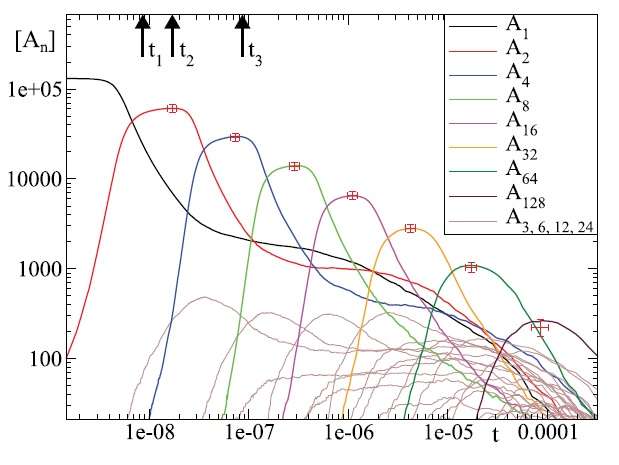November 8, 2016 feature
Model offers insight into how life continues to evolve

(Phys.org)—One of the most puzzling things about evolution is that, even after 4 billion years, it hasn't stopped. Instead of culminating in a single best adapted species, today the Earth contains an estimated 8.7 million different species, all of which will one day die out as a variety of new species takes their places.
Although scientists have tried to model these evolutionary dynamics in the lab, such as by using systems of molecules that change over time in some way, most of these models eventually generate a single dominant species and then come to a standstill. Scientists still don't completely understand how evolution continues to generate new species, which is known to occur even in the absence of changing external pressures.
Now in a new study, a team of physicists has developed a theoretical and experimental model of evolution that continues without end, even under constant external conditions. The model may help scientists better understand how the biosphere continues to evolve over billions of years.
"We hope to understand the necessary conditions of Darwinian statistics—notably, the coexistence of species that each have a finite lifetime—that emerge with Darwinian evolution," coauthor Albrecht Ott at Saarland University in Saarbruecken, Germany, told Phys.org. "This seems a major problem that research on the origin of life needs to deal with. Furthermore, molecular systems can help to elucidate mechanisms of speciation, notably the emergence and disappearance of niches."
The new model system consists of linear DNA polymers of different lengths, where the length of a polymer determines its "species." The polymers can reproduce (creating polymers of the same length) or join together via the polymer-binding enzyme DNA ligase (creating longer polymers, which are new species).
In their experiments, the researchers started with polymers that were 10 or 20 base pairs long. After exposing them to temperature variations that promoted reproduction and binding to various degrees, the researchers found that polymers of different lengths began to emerge.

The results revealed that species evolution depends on which growth mechanism dominates. In situations in which the ligation mechanism dominates, all possible polymer lengths are generated (all multiples of 20 starting with a length of 20, such as 40, 60, 80, and 100 base pairs and above).
But when reproduction dominates, only certain lengths appear (specifically, lengths of 10, 20, 40, 80, or 160 base pairs), and only for limited periods of time. Each polymer length follows a pattern in which its numbers exponentially increase, then plateau, and finally decrease, allowing new lengths of polymers to emerge.
In these reproduction-dominant situations, the evolution of polymers of different lengths bears similarities to Darwinian evolution. As the researchers explain, it is the dynamics of the entire system that selects a particular, new species (length of polymer) in such a way that it can use the existing situation most efficiently to multiply. Each time, the system escapes from this dominance by creating a new species that uses the new situation to its benefit.
"We believe that we have created a model system that exposes a dynamic mechanism reflecting essential traits of Darwinian evolution," said coauthor Karsten Kruse at Saarland University. "In a reproduction-dominated situation, in our system, only certain types of molecular reproducers occur: those that benefit most from a given situation. However, these 'species' fail to dominate the situation because of the emergence of ever new other species."
In the future, the researchers plan to modify the model so that the molecules acquire functionality, making them more similar to biological species.
"Although the simplicity of our system is what constitutes its quality and makes the message so clear, it is unclear how to devise a more complex system that enables new functionalities in a Darwinian setting," Ott said. "This is something we plan to address in the future."
More information: Emanuel Gregor Worst et al. "Unbounded growth patterns of reproducing, competing polymers—similarities to biological evolution." New Journal of Physics. DOI: 10.1088/1367-2630/18/10/103003
Journal information: New Journal of Physics
© 2016 Phys.org




















